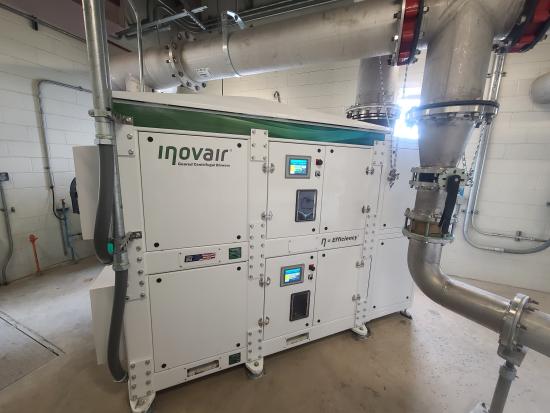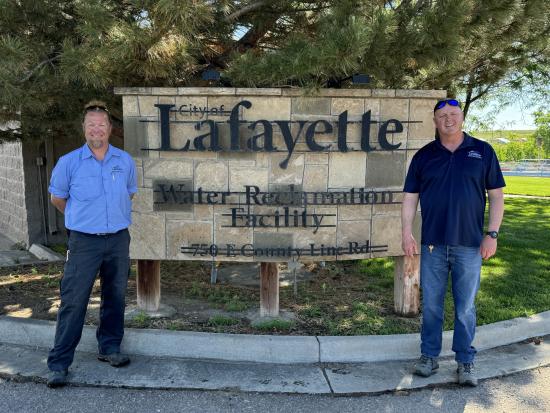The wastewater treatment plant (WWTP) for the City of Lafayette, Colorado, is a Class B biosolids facility. It meets grid regulations for volatiles reduction with at least a 38% reduction, and has a solids retention time (SRT) of at least 15 days at 95°F (35°C). Class B biosolids can be used as fertilizer for livestock feed and other applications that don’t directly lead to food for human consumption. The plant is a Class A facility overall, meaning it’s run by a certified class A operator.

Installed at the City of Lafayette, Colorado WWTP is a VFD integrally geared centrifugal blower.
The plant averages 2.4 millions of gallons per day (MGD), with a peak flow of 4 MGD in the middle of the day and just under 1 MGD in the middle of the night. The City of Lafayette has 30,000 residents. The plant uses UV disinfection.
A dissolved oxygen (DO) control system adjusts blower air flow rate to match process demand. VFD control is the most energy efficient method for modulating dynamic blowers. The Lafayette plant’s system is equipped with oxygen probes that tell valves to open and close. When more aeration is needed, they open, and when less is needed, they close. The blowers, however, run off header pressure: They try to maintain an 8 psi header no matter what position the valves are in.
If a wastewater treatment plant doesn’t have enough air (in the form of dissolved oxygen) the system can’t reduce ammonia (NH3). The goal is to use oxygen to turn NH3 into nitrate. Organisms in the anoxic zone convert the nitrate to nitrogen gas, which vents to the atmosphere and is harmless. The full system is called an aeration train, often shorted to “train.” The basic system consists of a primary clarifier, an aeration basin, a secondary clarifier and disinfection. The Lafayette plant supplies a level of 2 DO in its first aeration basin, then steps it down at the end of the basin so that it isn’t sending oxygen to the anoxic zone.
Searching for Aeration Efficiency at Partial Loads
In 2020, the Lafayette WWTP had a problem with limited turndown from its multistage centrifugal aeration blowers. The plant ran three 150-horsepower (hp) multistage centrifugal blowers which didn’t turndown well at partial load, wasting electricity. They frequently went into surge during the lower demand evening periods. They also had limited self-service options, so the plant operators needed to call in a service appointment for most maintenance tasks.
The solution, the plant’s leaders decided, was to find aeration blowers that performed efficiently at partial loads. They’d tried this once before, but their previous attempt was with a first-generation high-speed centrifugal blower that had significant issues related to its bearings.
Having a good impression of Inovair VFD geared aeration blowers, they contacted the company. But this time, rather than making a purchase outright, they wanted to start an on-premises trial.
"Inovair's compatibility with various blower technologies and all wastewater processes allows treatment plants to upgrade their blowers incrementally or all at once,” says Inovair CEO Ken Jones. “Our ability to integrate seamlessly, typically using existing pads and electrical with minimal piping modifications, ensures that upgrade construction costs remain low.”
“They liked our design – that it's highly efficient but serviceable at the plant level using industry standard components – but after feeling like they had gotten burned on their other high efficiency purchase, they wanted to test drive,” says David Sperber, Inovair’s Vice President of Sales. “It’s a little unusual for that to happen these days. You saw that more when we were a newer name in the market, but we're glad to prove ourselves.”
Leading the Lafayette trial were Blaine Kinkel, Water Reclamation Lead Operator, and Robert Hansen, Water Reclamation Manager. In May 2020, they took possession of a single-stage, 100-hp, oil-lubricated, VFD integrally geared centrifugal IM-30 blower. Their impressions were positive from the start.

Blaine Kinkel, Water Reclamation Lead Operator, and Robert Hansen, Water Reclamation Manager, for Lafayette, Colorado.
“We had a lot more control during low blow hours,” Kinkel says. “We weren't surging out our blowers in the middle of the night like we would previously. It also kept up with demand a little bit better and reacted quicker. During the day, when we have peak flows, our older blowers would struggle to keep up. Then, once they finally ramped themselves all the way up, they were blowing far too high and needed to turn themselves back down. All that was happening too slowly causing big swings in our DO.
“We've really flattened those excesses out. One of our issues was that we had a huge ammonia load coming into the aeration basin coming off our centrifugals. It was so bad we actually had to aerate our anoxic zone when we were running our centrifugals because we blow too much ammonia through the aeration basin. Once we got the Inovair blower we had fewer problems with that.”
A Five-Blower System With Efficiency and Redundancy
The WWTP trial lasted for over a year. When it was done, the city was ready to make a larger purchase.
“When we went into this next expansion, we were ready to go ahead and purchase four more 100-hp Inovair IM-30 VFD integrally geared centrifugal blowers in double-stack formation,” Kinkel says. “That's another nice thing about Inovair is you can get small footprints out of those blowers because you can stack them on top of each other. We have a double-stack on one end servicing one train, we have a double-stack on the other end to service our new train that we're about to put online and we've got a swing blower in the middle. That's the original Inovair that can service both sides if necessary.”
That means the plant has 500-hp in total, giving it plenty of redundancy. While the Inovair centrifugal blowers include onboard VFDs with internal DO sensors, the plant opted to use its own external sensors instead.
“We don't typically do this, but the plant requested we target a pressure and discharge instead of having the control system triggered by the DO level. So because we do all the programming and all the control system work in-house, we were able to accommodate their request on that and it works well,” Jones says.
“We’ve been really happy with these Inovair blowers,” Hansen adds. “They've been great to work with so far. We’ve had very few problems and the problems we've had have been minor.”

The Lafayette Wastewater Treatment Plant is now home to five Inovair IM-30 centrifugal blowers: four in double-stack configurations and one operating as a swing blower in the middle.
Geared Centrifugal Blowers Made in the U.S.A.
“The response from Inovair has been fantastic,” Kinkel adds. “I haven’t had to wait to get ahold of somebody. That can be a huge problem, just from a customer service standpoint. Inovair has been responsive, not to mention helping in troubleshooting. We had a 24-volt power supply go down and had a service tech on the phone trying to figure it out. He said, ‘Hey, are you down there? Go ahead and just take a picture on your phone. I bet I can figure it out from there.’ Sure enough, looking at the lights, he saw what was bad and shipped us a new one. We had it in a couple days.”
As Sperber likes to point out, the fact that Inovair’s VFD integrally geared centrifugal blowers are made in the United States – the company currently offers the only high-efficiency blower for the wastewater industry made entirely in America – give it other advantages, as well.
If somebody mis-sizes the aero stage, it's easy for Inovair to make a change, Sperber says. “For other blower manufacturers, especially with a centrifugal blower, you're talking about shipping it back to the factory in Asia and that’s a huge turnaround time.” But Inovair can change an aero stage in a matter of days at its plant.
For the City of Lafayette Wastewater Treatment Plant, it all adds up to a successful partnership.
“I personally have never run across a blower that I feel is as bulletproof and as easy to maintain as this one is,” Kinkel says.
Three Aeration Blower Design Improvements for the Maintenance CrewLower power consumption and 50% turndown aren’t the only reasons the City of Lafayette ordered four additional Inovair VFD integrally geared centrifugal IM-30 blowers after its one-year trial was over. Here are three reasons why the team at the city’s wastewater treatment plant knows they made the right decision. 1. Ease of Access. Internal filters for oil and the heat sink are easily accessible, so operators don’t need to step inside the cabinet to reach them. “The way they have this designed is you open your cabinet doors and they actually have hoses reconnected to the areas that need oil,” says Blaine Kinkel. “All you have to do is pull those hoses out, get your bucket underneath, cap it, let it drain, get the other side, fill it up, bump it in. Easy,” Kinkel says. “You don't have to contort yourself. They thought about operators when they designed the machine.” 2. Sturdy. Fast pressure changes can damage blowers. Here, sensors and onboard intelligence detect pressure changes immediately and dump the load before any damage is done. “Even if you slam the discharge valve close by hand, that thing will react in a split-second by reading that over pressure and shutting itself down before it damages itself,” Kinkel says. 3. No Grease Needed. None of the parts need grease applied, which Kinkel thinks is fantastic. For someone tasked with maintenance, that’s one less thing to worry about. |
About Inovair
Inovair is the industrial products division of Accessible Technologies, Inc. The company was founded in 1994 to expand the application of high efficiency geared centrifugal blower technology within forced induction, aerospace, municipal and industrial applications. All Inovair activities, including engineering, manufacturing and service, are performed in the USA. For more information, visit https://inovairblowers.com.
To read similar articles on Wastewater Treatment Plants please visit
https://www.blowervacuumbestpractices.com/industries/wastewater.
Visit our Webinar Archives to listen to expert presentations on Aeration Blower Systems at https://www.blowervacuumbestpractices.com/magazine/webinars.



